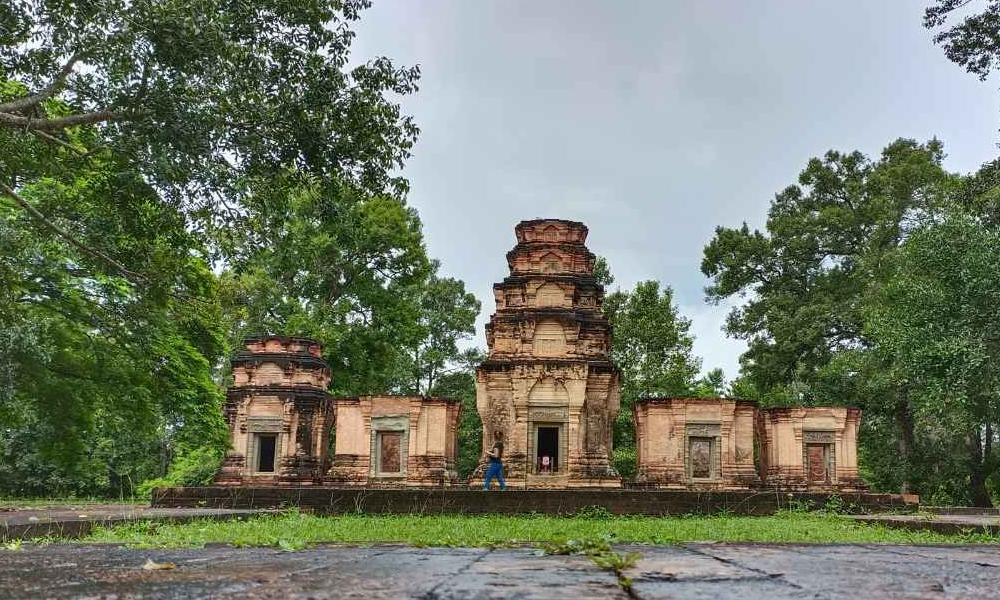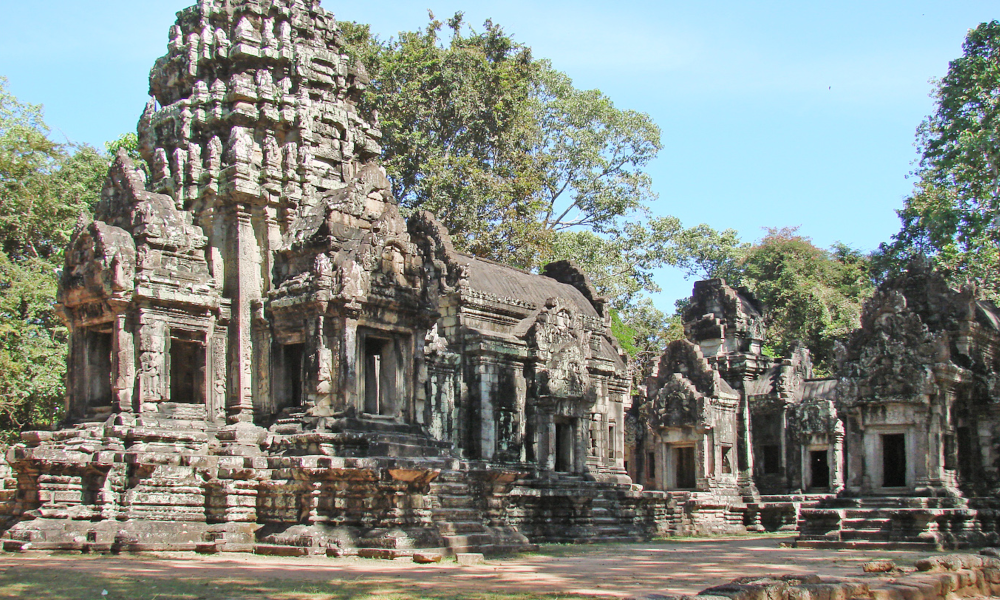Prasat Kravan Temple

Prasat Kravan is a Hindu temple from the 10th century, originally dedicated to Vishnu. It features five brick towers aligned to the east and is encircled by a modest moat. Notably, the temple was not commissioned by a king; rather, it was built by high-ranking officials during the reign of King Harshavarman I or Ishanavarman II.
This temple is frequently included in both the Grand Circuit and Small Circuit tours. If your itinerary allows, it is certainly a site worth visiting. Prasat Kravan remains in relatively good condition, and its symmetry and architectural lines provide excellent opportunities for photography.
The Angkor Wat Small Circuit Tour stands out as the most favored excursion for those visiting Angkor Wat. This tour provides the opportunity to witness...
Layout and Design
There are five sanctuary towers of varying sizes, with the central tower being the most prominent and the outer towers being the smallest. All towers are oriented towards the east and are aligned along a north-south axis. Surrounding the temple is a moat.
The interiors of the towers exhibit distinctive features of Khmer architecture. Notable are the large carvings of the Hindu deities Lakshmi and Vishnu, which have been intricately sculpted into the brick walls. This style of sculpture is more typically associated with Cham monuments than with Khmer temples.
Access to the moat is provided from the west via a small causeway. Upon crossing, one can observe the five towers positioned on an elevated terrace. It is likely that an entrance gate existed at this location, although it would have been constructed from perishable materials such as wood or bamboo.
Lion statues were originally placed outside the stairways leading to each tower; however, only a few remain today, and most are not currently visible.
An inscription at the entrance of the central tower indicates that the temple was dedicated to a statue of Vishnu in the year 921 AD.
The Vishnu Bas-Reliefs
Prasat Kravan is particularly renowned for the exceptional quality of three bas-reliefs depicting Vishnu. Two of these bas-reliefs portray a four-armed Vishnu. In one, he is seated, holding a baton, discus, conch, and globe. In the other, he stands while holding the same items and appears to be taking a significant step. This bas-relief narrates the tale of Vishnu assuming the form of a dwarf named Vamana and taking three giant strides to claim the earth.
The third bas-relief features an eight-armed Vishnu, who is depicted amidst his devotees, along with the representation of a lizard.
Other Bas-Reliefs
Additionally, there are two bas-reliefs of Lakshmi located in the north tower. As the consort of Vishnu, Lakshmi is shown in both depictions surrounded by her followers. In one, she holds Vishnu’s discus and Shiva’s trident, while in the other, she is depicted with lotuses.
History of Kravan Temple
Prasat Kravan was constructed in 921 AD during the 10th century by prominent officials under the rule of Harshavarman I or Ishanavarman II. Initially, the temple was dedicated to the deity Vishnu. However, limited information is available regarding the temple’s functions or its historical significance.
Similar to many temples in the area, it is believed that Prasat Kravan fell into disuse at some point during the 16th century.
In the 1930s, the site underwent restoration efforts led by two French explorers, Georges Trouve and Henri Marchal. These efforts were temporarily halted due to the Japanese invasion in World War II. Subsequently, in the 1960s, the site was further restored by Bernard Philippe Groslier and his team, during which new bricks were incorporated. These new bricks can be easily distinguished as they bear the inscription “CA,” which stands for “Conservation Angkor.”
Why Visit Prasat Kravan
Visiting Prasat Kravan is highly recommended due to its distinctive architectural features that are uncommon among Khmer temples. The bas-reliefs here remain remarkably well-preserved.
While Prasat Kravan attracts a fair number of visitors, it does not rank among the most frequented sites. This allows for the opportunity to capture excellent photographs without the interference of large crowds. Additionally, the symmetrical towers provide an appealing backdrop for photography.
Location & How to Get There
Other Temples
-
Ak Yum Temple
-
Tep Pranam Temple
-
Khleangs Temple
-
Spean Thma
-
Prasat Suor Prat
-
Preah Pithu Group
-
Preah Palilay
-
Terrace of the Leper King
-
Terrace of the Elephants
-
Phimeanakas Temple
-
Banteay Prei Temple
-
Banteay Srei Temple
-
Prasat Kravan Temple
-
Ta Keo Temple
-
Chau Say Tevoda Temple
-
Thommanon Temple
-
Pre Rup Temple
-
East Mebon Temple
-
Ta Som Temple
-
Neak Pean Temple
-
Phnom Bakheng
-
Phnom Krom Mountain
-
Preah Khan Temple
-
Roluos Group
-
Banteay Kdei Temple
-
Baphuon Temple
-
Banteay Samre Temples
-
Beng Mealea Temple
-
Ta Prohm Temple
-
Bayon Temple
-
Angkor Thom Temple
-
Angkor Wat Temple
Experiences in Siem Reap
-
Cambodia Visa Requirements: All thing you need to know
-
Cambodia SIM Card: How to buy and price details
-
Money Exchange in Cambodia: What travelers need to know?
-
Useful Contacts For Travelers In Cambodia
-
Tourist Info Center: When Travel in Cambodia
-
Angkor Archeological Park
-
Suggested Siem Reap Itineraries
-
Reasons Against Financial Assistance to Begging Children
-
Pub Street
-
Siem Reap’s Local Markets
Cambodia Guide
-
Preah Vihear Province
-
Tonel Sap
-
Siem Reap Province
-
Cambodia Seasons
-
Mekong River
-
Battambang Province
-
Kampot
-
Sihanouk Ville
-
Phnom Penh: The campital city of Cambodia
-
National Religion of Cambodia - Buddhism
-
The History of Cambodia
-
Introduction to Cambodia
-
Public Holidays in Cambodia
-
Best Time to Visit Cambodia

